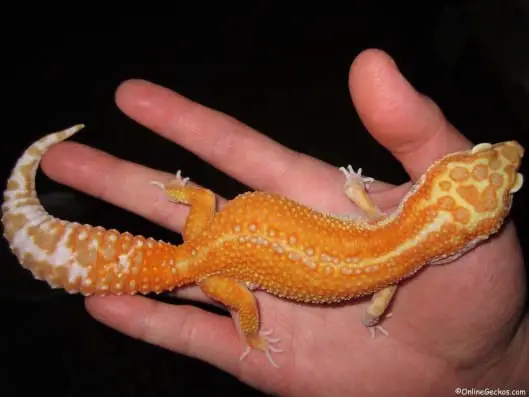Various factors such as physiological stress, preventative veterinary care, size, and nutrition affect a gecko lizard’s sexual maturity. They can produce eggs even without mating with a male, so they’re at risk of suffering from dystocia. Also known as egg binding, dystocia occurs when a female gecko lizard can’t pass her eggs.
Complications of dystocia include scarring and inflammation of the female’s reproductive tract, peritonitis, and death of the eggs or hatchlings. A female gecko lizard can also die due to this condition.
What Are the Symptoms and Causes of Dystocia?
A female gecko lizard that can’t give birth or pass her eggs often acts fidgety and constantly tries to find a place to dig. Other symptoms of dystocia include a swollen cloaca and straining. She may become lethargic and depressed as her condition worsens. Tissue may also protrude from her cloaca.
Dystocia can be caused by various factors such as a malformed or overly large egg or one that’s broken, fractured, or not positioned properly. Egg binding might occur due to an anatomical abnormality in the female, making it physically impossible for her to pass eggs. Dystocia is also linked to poor husbandries such as dehydration, wrong humidity level, insufficient nest site, wrong temperature, poor lighting, and improper environment.
Lizards need a quiet area where they can lay eggs. It should have the right selection and depth of the substrate. Obesity, stress, malnutrition, infections, abscesses, constipation and diseases may also cause egg binding. Excessive bleeding may lead to dystocia, as well.
Other factors that can cause egg binding include the lizard’s physical condition and age. Inactive gecko lizards may not be able to produce strong, constant contractions needed to lay eggs. She may become worn out before she passes all of her eggs. Lizards may be out of shape because of their sedentary captive lifestyle. A gravid gecko lizard that’s suffering from egg binding is anorectic but quickly becomes unresponsive or sick.
How is Dystocia Diagnosed?
The vet can confirm whether there are eggs in the female’s reproductive tract by conducting abdominal exams, X-rays, and ultrasounds on the reptile. Blood work is beneficial in some cases, as well. The vet will be able to determine the main cause of the problem.
Sometimes, it’s hard to distinguish between dystocia and normal laying and birthing. Radiographs are usually conducted to determine the location, number, size, and shape of retained eggs. The vet may also conduct an ultrasound on the reptile. The gecko’s history is crucial, including the date of shedding and mating as well as how long ago the symptoms appeared.
Laboratory testing and a physical exam may help determine other possible causes of the symptoms. A female gecko lizard may be able to lay a couple of eggs and rest for a bit. However, she should be able to lay her eggs in less than 2 days or 48 hours. If she’s starting to look sick or stressed, you have to take her to the vet to get proper treatment.
How to Help a Gecko Lizard with Dystocia Lay Eggs
Basic Guide to Caring For and Handling Leopard Geckos!!
Video Link: https://www.youtube.com/watch?v=xuGEbfAk2FM
If the lizard seems to be in good condition, you can help her lay eggs by giving her an appropriate nesting site in a properly humidified and heated terrarium. You should also leave her undisturbed. Applying treatment before getting a proper diagnosis may harm the female and the eggs.
Delaying or withholding treatment can be detrimental to the female and her eggs as well. Once she starts laying eggs, treatment should be applied within 2 days or 48 hours. Sometimes, they will complete laying all eggs within 48 hours after resting for a bit. Here are other ways to help a gecko lizard with dystocia lay eggs.
· Hormonal Stimulation
Using posterior pituitary hormones to stimulate oviductal contractions is not only ineffective but may also be dangerous to females carrying enlarged, misshapen, or malformed eggs. This method may also cause further harm to females suffering from oviduct obstruction or oviduct or pelvis deformity. Using oxytocin may lead to oviductal hemorrhage or egg rupture and death.
Oxytocin is most effective when given within the first 48-hour window. It’s given through intracoelomic or intramuscular injection. Another dose is often administered 20 to 60 minutes after the initial injection. The effectiveness of oxytocin depends on the right temperature.
Arginine vasotocin is the oxytocin present in reptiles like gecko lizards. It’s more effective compared to oxytocin, but it’s more expensive as well. It’s also a research drug. Estrogen and progesterone may be administered to boost oxytocin’s efficacy. However, there are no studies that can verify the usefulness of these hormone treatments.
Sometimes, calcium is administered through injection before giving hormones to the reptile. Arginine vasotocin or oxytocin should not be administered if the female can’t lay eggs due to an obstruction. Her eggs or reproductive tract could rupture if she’s given arginine vasotocin or oxytocin.
· Physical Manipulation
Another way to help gecko lizards with dystocia lay eggs is through physical manipulation. You have to softly but firmly massage each egg out by simply running your finger down her belly. However, this technique is dangerous as it may cause a prolapse or rupture in the oviduct, break the eggs and, thus, kill the lizard.
· Surgery
The eggs can be surgically removed as well. Before proceeding, the vet may try to manually manipulate the eggs one last time to reduce the risk to the lizard as the anesthesia will relax her oviductal sphincter. Extreme care should be observed in order to avoid rapture or prolapse.
The vet will get rid of all or some of her reproductive tissues or remove only the eggs, depending on what he discovers once he opens her belly. If you don’t have plans to breed the female, you can ask for an ovariosalingectomy to be done simultaneously to prevent egg binding in the future.
· Aspiration
Dystocia is usually treated through aspiration. A needle is inserted into the eggs, and the contents are aspirated. It results in a smaller egg that can pass through the cloaca and oviduct much more easily. If contractions don’t occur within a few days or hours, it could be triggered by administering oxytocin.
However, caution should be taken to prevent the egg content from entering the coelomic cavity. You should do this method within 48 hours after cessation of all natural laying endeavors. After this period, the contents of the eggs will start to harden. The only way to get rid of them is to have them surgically removed.
Fertile eggs that are eliminated by administering oxytocin to females that are not suffering from dystocia have a higher chance of hatching. Eggs from dystocic females, however, may not hatch at all.
What to Expect After Treatment
The overall physical state of the lizard is the biggest factor that will determine her post-retention survival. Most gecko lizards are severely weakened due to dystocia. Those who are in good hydration, physical, and nutritional states have a higher chance of recovering. It is also possible for reptiles with only one reproductive tract to successfully lay eggs in the future.
If you’re not sure whether your gecko lizard is carrying eggs or not, it is best that you don’t wait it out. This is particularly important if you’re not sure whether your pet is suffering or not. Take her to a reptile veterinarian to determine what you’re dealing with and get the right treatment for your pet.
How to Prevent Dystocia
If your pet is treated promptly and generally healthy, she will most likely recover. Female lizards that have had difficulty passing eggs in the past are much more likely to have similar issues in the future. One of the best ways to prevent dystocia is to keep gecko lizards in an enclosure that promotes physical activity. You should also feed them properly and provide sufficient nesting sites, temperature gradients, and humidity levels.
In other words, proper nutrition and husbandry are the keys to preventing egg binding in gecko lizards. According to vets, most of the problems could be prevented through proper management. You should also use only those at the right age, condition, and size for breeding. Get rid of those that have had reproductive problems in the past.
The cage of the lizard should be placed in a private, quiet area. It should be spacious enough for your pet and have the right furnishings to allow her to move about easily and maintain her muscle tone. Sufficient mineral intake is also important. Always keep a record of the dates of shedding and mating as it will help you determine if egg binding is present. Since female lizards can produce eggs without mating with a male, isolating them from the males won’t solve the problem. If she is healthy, however, she will most likely recover and be able to lay eggs if her reproductive tract was not removed or damaged. If dystocia was caused by malnutrition or poor husbandry and these problems were not solved, this life-threatening condition will more likely happen again.



